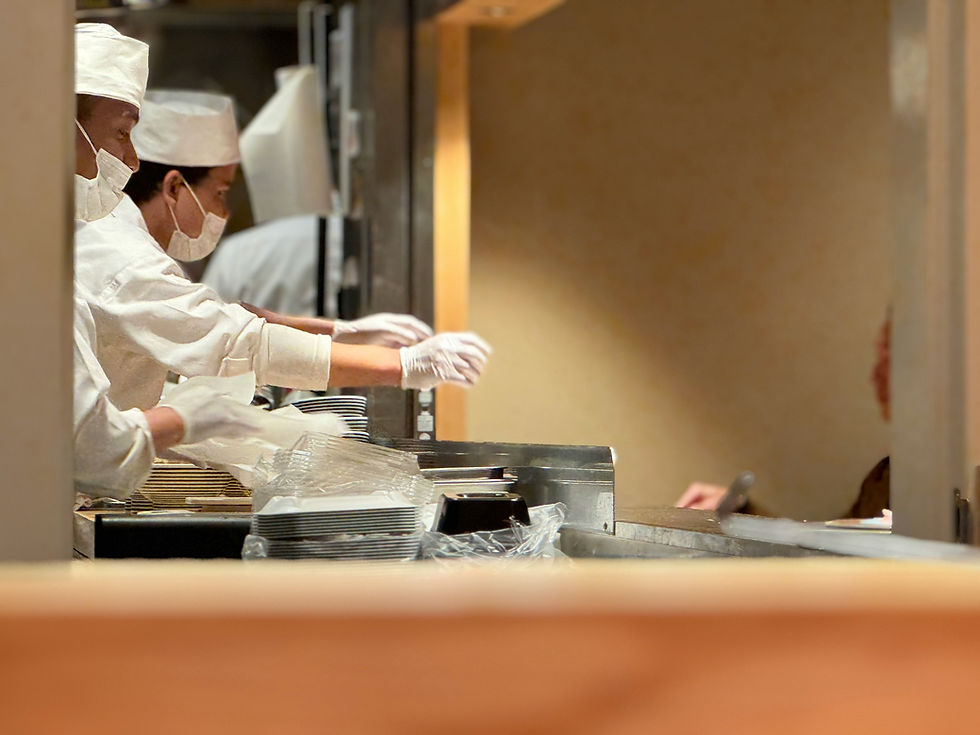How Aroma Shapes Memory, Taste, and Wellbeing-A conversation on scent, flavor, and the art of feeling.【#003】
- amika
- Jul 17
- 5 min read
Updated: Jul 31
Have you ever caught a scent that instantly brought back a memory?
Or felt a wave of comfort wash over you from the aroma of something familiar?
Aroma doesn’t just add to flavor—it can be the key that unlocks emotion.
It’s both a part of taste, and a trigger for feeling.
In this edition, we explore the connection between aroma, memory, and healing
with Lawrence Nakamura—a certified sake and wine sommelier who has spent years on the front lines of the culinary world.
Together, we’ll follow the trail of scent and discover how it shapes our experiences of both deliciousness and well-being.
The Tongue Measures Intensity. The Nose Measures Quality.
Interviewer:
I’ve heard that our sense of smell plays a bigger role in taste than our tongue.
Is that true? Do you see smell as more important than taste?
Lawrence:
It’s not about which is “better” or “stronger.”
Taste and smell each have different roles to play—they’re good at different things.
The nose is especially good at measuring quality.
It tells us what ingredients are present, what the character or identity of the food is.
On the other hand, the tongue is good at measuring intensity.
It picks up on how salty something is, how strong or weak the texture feels.
Each sense has its own specialty—like different tools in a toolkit.
The Senses as a Safety System
Lawrence:
Animals often sniff something first to decide if it’s safe to eat.
We humans do this too.
Imagine some natto that’s past its expiration date.
You might hesitate, right? But you still smell it first—it’s a natural reflex.
Smell is the first checkpoint in our internal “safety system.”
From there, we taste it on the tongue, and aroma travels back up through the nose.
All of these steps work together to create what we experience as “flavor.”
So our senses don’t just help us enjoy food—they also protect us.

Flavor Is a Mental Edit
Interviewer:
When I sip tea or broth, I feel like I’m enjoying the whole experience—smell, taste, everything.
So what’s really happening when we say something tastes “delicious”?
Lawrence:
That’s such an important question.
First, we need to distinguish between aroma and flavor.
They’re not the same thing.
Flavor is created when all the elements—smelling, tasting, and retronasal aroma (from inside the mouth)—are integrated by the brain.
The brain edits all that input and labels it: “This is strawberry,” “This is umami,” etc.
In other words, flavor isn’t just taste—it’s the brain’s synthesis of the senses.
Smell Triggers Memory, Imagination—and Illusion
Lawrence:
Aroma, temperature, color, texture—when these combine, they can change how something tastes entirely.
So in a way, deliciousness is also about edited memory.
Smell and flavor can trigger imagination, and even create illusions.
Take the brightly colored syrups you see on shaved ice at summer festivals.
Even if it says “melon,” there’s no real melon juice.
But the color, chill, sweetness, and slight acidity trick your brain:
“Ah! Melon flavor!”
Or think of a Long Island Iced Tea.
There’s no actual tea in it, but the blend of alcohols and aromas makes you feel like you’re drinking iced tea.
That’s a pure sensory illusion.

To Feel Something Is to Heal Something
Interviewer:
We often hear that good smells—like aromatherapy—can help us relax. What’s your take on that?
Lawrence:
Yes, but I always feel a bit skeptical when people say,
“This specific aroma will do this specific thing for you.”
To me, it’s less about “what effect it has,” and more about how you experience it.
What matters is:
When I smell this, how do I change? What do I notice?
That process—being aware of what you’re sensing—is what heals.
It’s not the scent itself.
It’s the act of feeling that becomes a form of care.

Craving Intensity: IPA Beer, Gin, and the Desire to Feel
Lawrence:
In our busy modern lives, we often lose touch with our senses.
We stop noticing. We stop feeling.
But the act of feeling something—anything—is, in itself, a form of stress relief.
When our senses, especially our sense of smell, become dull,
stress tends to build up without us even realizing it.
That’s why people instinctively crave strong sensations—
heat, cold, sourness, bitterness.
We’re trying to reset our overloaded systems.
Think of the recent rise in popularity of IPA beers and gins.
IPAs (India Pale Ales) are bold craft beers known for their generous use of hops,
offering intense bitterness and bright, floral or citrus aromas.
Gin, too, with its herbal complexity, delivers a punch of flavor and fragrance.
What these drinks have in common is impact.
Their aromas hit you. They make you feel.
In a way, our attraction to them might reflect the pressure we’re under—
a kind of subconscious craving:
“I just want to feel something.”

What You Feel (or Can’t) Reflects Where You Are
Interviewer:
That’s fascinating. So maybe the things we’re drawn to reveal something about our current emotional state?
Lawrence:
Exactly.
It’s not about being able to name the scent or understand it perfectly.
It’s about whether or not you’re feeling something at all.
And that alone can tell you a lot about where you’re at.
It’s totally fine if you can’t identify the aroma.
It’s okay if you don’t get the flavor.
Sometimes, the most important thing is just giving yourself permission to enjoy not knowing.
If you feel like you can’t even do that…
Maybe it’s time to sleep instead of trying to do more. (laughs)
Let’s not overload ourselves with information.
Instead, let’s take time to gently reconnect with our senses.
That alone is enough.
Editor’s Note
This time, we followed the thread of aroma—
that invisible presence that quietly colors our experience of flavor.
What we found was simple, yet deeply human:
Sometimes, just pausing to notice a scent
can become a mirror for how we’re really doing.
In a world that moves fast,
these small, sensory moments help us return to ourselves.
We’ll keep exploring the many layers of “deliciousness” in the issues to come.
Thanks for reading—and see you next time.
Yoshihito “Lawrence” Nakamura
Certified Sake Sommelier / Wine Sommelier
With deep expertise in both sake and wine, Lawrence has been involved in launching restaurants, curating beverage programs, and advising food and drink brands. He joined the Apoptosis team in 2024.
His work has been recognized with numerous awards, including
“Best Sake List in Japan” and “Most Original Wine List in Asia.”
Apoptosis also regularly hosts tasting events for non-alcoholic beverages,especially for professionals in the food and beverage industry.For more details, please visit the page linked below.



